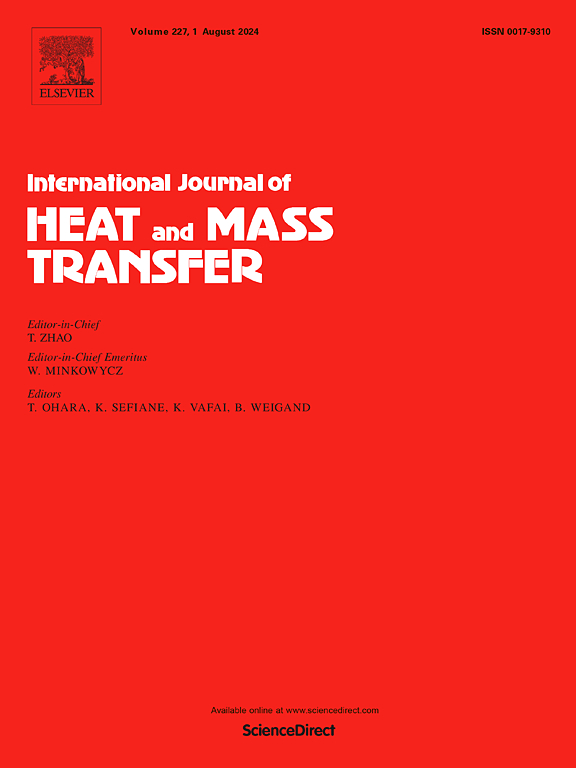Enhancing performance of oblique double layer plate microchannel heat exchanger by computational fluid dynamics: Design and performance optimization
IF 5.8
2区 工程技术
Q1 ENGINEERING, MECHANICAL
International Journal of Heat and Mass Transfer
Pub Date : 2025-02-24
DOI:10.1016/j.ijheatmasstransfer.2025.126865
引用次数: 0
Abstract
This study aims to improve the performance of oblique microchannel heat exchangers by modifying conventional straight microchannel configurations. A simulation model using computational fluid dynamics (CFD) is developed to evaluate the efficiency of the heat exchanger by analyzing design parameters such as microchannel width, primary to secondary channel width ratio, and number of oblique cuts along the microchannel. Coefficient of performance (COP) a forthright metric for assessing the interaction between operating parameters and achieving optimal performance is proposed. Utilizing a width of 0.48 mm, path ratio of 2.06, and oblique ratio of 1.61, significant improvements in heat transfer and performance efficiency are achieved. The optimized design leads to a substantial reduction in fabrication material, potentially using more than half less material than before. The optimized design of the oblique microchannel heat exchanger strikes a balance between hot flue gas temperature and coolant Reynolds Number (Re) in a waste heat recovery system which considering waste flue gas from the most common boiling process in industry. The results indicate a promising improvement in hydrothermal performance of 8.48% compared to the baseline case of straight microchannel design, resulting in cost savings and enhanced economic sustainability. These findings establish the oblique microchannel heat exchanger as a viable solution for waste heat recovery systems, showcasing its potential for efficient energy reutilization.

用计算流体力学提高斜双层板微通道换热器性能:设计与性能优化
本研究旨在通过改变传统的直微通道结构来改善斜微通道换热器的性能。通过分析微通道宽度、主副通道宽度比、微通道斜切口数等设计参数,建立了计算流体力学(CFD)仿真模型,对换热器的效率进行了评价。提出了一种评价运行参数之间相互作用和实现最优性能的直接度量——性能系数。利用0.48 mm的宽度,2.06的径比和1.61的斜比,显著改善了传热和性能效率。优化的设计导致制造材料的大幅减少,可能使用比以前少一半以上的材料。考虑到工业中最常见的沸腾过程产生的废烟气,斜微通道换热器的优化设计在热烟气温度和冷却剂雷诺数(Re)之间取得了平衡。结果表明,与直接微通道设计的基线情况相比,热液性能有了8.48%的改善,从而节省了成本,提高了经济可持续性。这些发现确立了倾斜微通道热交换器作为废热回收系统的可行解决方案,展示了其高效能源再利用的潜力。
本文章由计算机程序翻译,如有差异,请以英文原文为准。
求助全文
约1分钟内获得全文
求助全文
来源期刊
CiteScore
10.30
自引率
13.50%
发文量
1319
审稿时长
41 days
期刊介绍:
International Journal of Heat and Mass Transfer is the vehicle for the exchange of basic ideas in heat and mass transfer between research workers and engineers throughout the world. It focuses on both analytical and experimental research, with an emphasis on contributions which increase the basic understanding of transfer processes and their application to engineering problems.
Topics include:
-New methods of measuring and/or correlating transport-property data
-Energy engineering
-Environmental applications of heat and/or mass transfer

 求助内容:
求助内容: 应助结果提醒方式:
应助结果提醒方式:


